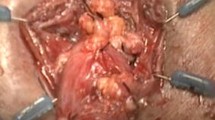Abstract
Background
The feasibility of transanal rectosigmoid resection with transanal endoscopic microsurgery (TEM) was previously demonstrated in a swine nonsurvival model in which transgastric endoscopic assistance also was shown to extend the length of colon mobilized transanally.
Methods
A 2-week survival study evaluating transanal endoscopic rectosigmoid resection with stapled colorectal anastomosis was conducted with swine using the transanal approach alone (TEM group, n = 10) or a transanal approach combined with transgastric endoscopic assistance (TEM + TG group, n = 10). Gastrotomies were created using a needleknife and balloon dilation, then closed using prototype T-tags. Outcomes were evaluated and compared between the groups using Student’s t-test and Fisher’s exact test.
Results
Relative to the TEM group, the average length of rectosigmoid mobilized in the TEM + TG group was 15.6 versus 10.5 cm (p < 0.0005), the length of the resected specimen was 9 versus 6.2 cm (p < 0.0005), and the mean operative time was 254.5 versus 97.5 min (p < 0.0005). Intraoperatively, no organ injury or major bleeding was noted. Two T-tag misfires occurred during gastrotomy closure and four small staple line defects requiring transanal repair including one in the TEM group and three in the TEM + TG group (p = 0.2). Postoperatively, there was no mortality, and the animals gained an average of 3.4 lb. Two major complications (10%) were identified at necropsy in the TEM + TG group including an intraabdominal abscess and an abdominal wall hematoma related to T-tag misfire. Gastrotomy closure sites and colorectal anastomoses were all grossly healed, with adhesions noted in 60 and 70% and microabscesses in 50 and 20% of the gastrotomy sites and colorectal anastomoses, respectively.
Conclusions
Natural orifice translumenal endoscopic surgery (NOTES) for rectosigmoid resection using TEM with or without transgastric endoscopic assistance is feasible and associated with low morbidity in a porcine survival model. Transgastric assistance significantly prolongs the operative time but extends the length of the rectosigmoid mobilized transanally, with a nonsignificant increase in complication rates related to gastrotomy creation.




Similar content being viewed by others
References
Whiteford MH, Denk PM, Swamstrom LL (2007) Feasibility of radical sigmoid colectomy performed as natural orifice traslumenal endoscopic surgery (NOTES) using transanal endoscopic microsurgery. Surg Endosc 21:1870–1874
Sylla P, Willingham FF, Sohn DK, Gee D, Brugge WR, Rattner DW (2008) NOTES rectosigmoid resection using transanal endoscopic microsurgery (TEM) with transgastric endoscopic assistance: a pilot study in swine. J Gastrointest Surg 12:1717–1723
Fong DG, Pai RD, Thompson CC (2007) Transcolonic endoscopic abdominal exploration: a NOTES survival study in a porcine model. Gastrointest Endosc 65:312–318
Fong DG, Ryou M, Pai RD, Tavakkolizadeh A, Rattner DW, Thompson CC (2007) Transcolonic ventral wall hernia mesh fixation in a porcine model. Endoscopy 39:865–869
Wilhelm D, Meining A, von Delius S, Fiolka A, Can S, Hann von Weyhern C, Schneider A, Feussner H (2007) An innovative, safe, and sterile sigmoid access (ISSA) for NOTES. Endoscopy 39:401–406
Pai RD, Fong DG, Bundga ME, Odze RD, Rattner DW, Thompson CC (2006) Transcolonic endoscopic cholecystectomy: a NOTES survival study in a porcine model (with video). Gastrointest Endosc 64:428–434
Ryou M, Fong DG, Pai RD, Sauer J, Thompson CC (2008) Evaluation of a novel access and closure device for NOTES applications: a transcolonic survival study in the porcine model (with video). Gastrointest Endosc 67:964–969
Ryou M, Fong DG, Pai RD, Tavakkolizadeh A, Rattner DW, Thompson CC (2007) Dual-port distal pancreatectomy using a prototype endoscope and endoscopic stapler: a natural orifice transluminal endoscopic surgery (NOTES) survival study in a porcine model. Endoscopy 39:881–887
Leroy J, Cahill RA, Perretta S, Forgione A, Dallemagne B, Marescaux J (2009) Natural orifice translumenal endoscopic surgery (NOTES) applied totally to sigmoidectomy: an original technique with survival in a porcine model. Surg Endosc 23:24–30
Dubcenco E, Grantcharov T, Streutker CJ, Rotstein OD, Baxter NN, Jeejeebhoy KN, Baker JP (2008) The development of a novel intracolonic occlusion balloon for transcolonic natural orifice transluminal endoscopic surgery: description of the technique and early experience in a porcine model (with videos). Gastrointest Endosc 68:760–766
Bachman SL, Sporn E, Furrer JL, Astudillo JA, Cataluce R, McIntosh MA, Miedema BW, Thaler K (2009) Colonic sterilization for natural orifice translumenal endoscopic surgery (NOTES) procedures: a comparison of two decontamination protocols. Surg Endosc. doi:10.1007/s00464-008-0295-0
Narula VK, Hazey JW, Renton DB, Reavis KM, Paul CM, Hinshaw KE, Needleman BJ, Mikami DJ, Ellison EC, Melvin SW (2008) Transgastric instrumentation and bacterial contamination of the peritoneal cavity. Surg Endosc 22:605–611
Willingham FF, Gee D, Sylla P, Kambadakone A, Sahani DV, Singh A, Mino-Kenudson M, Rattner DW, Brugge WR (2008) A prospective randomized controlled trial of NOTES versus laparoscopic distal pancreatectomy: preliminary results. Gastrointest Endosc 67:106
Sporn E, Bachman SL, Miedema BW, Loy TS, Calaluce R, Thaler K (2008) Endoscopic colotomy closure for natural orifice transluminal endoscopic surgery using a T-fastener prototype in comparison to conventional laparoscopic suture closure. Gastrointest Endosc 68:724–730
Acknowledgments
We acknowledge Christopher Hoffman, BA, for his help and expertise with perioperative animal care, and Drs. Desilets, Romanelli, Romero, and Earle and Vihar Surti (biomedical engineering) who developed the T-tag gastrotomy closure prototype. This work was supported by a research grant from NOSCAR (Natural Orifice Consortium for Assessment and Research).
Disclosures
Patricia Sylla is a consultant for Covidien; William R. Brugge is a consultant for Boston Scientific; and David W. Rattner is a consultant for Olympus. Dae Kyung Sohn, Sevdenur Cizginer, Yusuf Konuk, Brian G. Turner, Denise W. Gee, Field F. Willingham, Maylee Hsu, and Mari Mino-Kenudson have no conflicts of interest or financial ties to disclose.
Author information
Authors and Affiliations
Corresponding author
Rights and permissions
About this article
Cite this article
Sylla, P., Sohn, D.K., Cizginer, S. et al. Survival study of natural orifice translumenal endoscopic surgery for rectosigmoid resection using transanal endoscopic microsurgery with or without transgastric endoscopic assistance in a swine model. Surg Endosc 24, 2022–2030 (2010). https://doi.org/10.1007/s00464-010-0898-0
Received:
Accepted:
Published:
Issue Date:
DOI: https://doi.org/10.1007/s00464-010-0898-0




